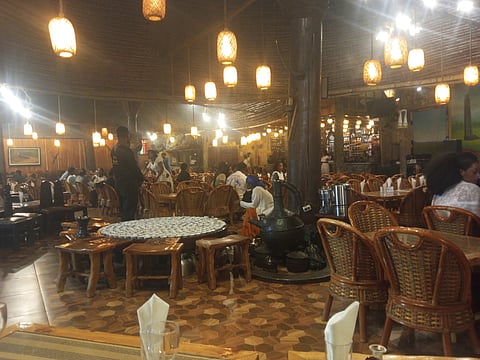

Totot in Addis Ababa blends live music, ancient recipes and climate-smart cooking methods.
Traditional restaurants across Africa are reclaiming space amid modern fast food chains.
Indigenous grains, wood-fired stoves and seasonal menus show how food traditions adapt to climate pressures.
Waitresses and musicians act as cultural custodians, keeping rituals and skills alive for new generations.
From Ethiopia to Ghana and Nigeria, dining tables are becoming sites of heritage and resilience.
The aroma of sizzling beef and roasted coffee beans drifts through Totot, one of Addis Ababa’s most celebrated traditional restaurants. Waiter Yiednek Ahew, in a crisp white shirt and floral vest, carries a steaming platter of beef shekela with injera flatbread and berbere sauce. “Your meal, sir, fresh and hot,” he announces, his voice almost drowned by the hum of conversation.
For a group of African journalists, just out of a conference at the Nexus Hotel, the pull of Totot was irresistible. The bustle of skyscrapers and highways outside seemed to fade as they entered. Inside, the mud-plastered walls, thatched tukul roof and hand-carved wooden chairs transported them to another time, where tradition and hospitality still define the rhythm of daily life.
Totot’s mud walls echo with azmari minstrels playing the masinko, a one-stringed fiddle, while waitresses in white habesha kemis pour injera batter onto clay griddles and roast coffee beans over open flames. The name “habesha”, evoking diversity, captures the mix of diners: Locals, Europeans, Indians, Chinese and travellers from across the world sharing a meal.
“I come here whenever I visit Addis,” said Norwegian tourist Hege Nilsen, sipping honey wine. “It’s not just the food, it’s the music, the smells, the way the traditions are alive. You see sustainable practices in action.”
Even the chairs are part of that story. Carved from single blocks of hardwood, they bear crosses, lions and looping patterns recalling the Lion of Judah and Jimma thrones once reserved for royalty. Sitting on them, diners find themselves in what feels like a living archive of Ethiopian memory and symbolism.
The restaurant is also a showcase for climate resilience. Its signature injera is made from teff, a drought-resistant grain cultivated in nearby highlands. Cooking methods emphasise efficiency: wood-fired stoves are tended to reduce smoke and save fuel, echoing practices honed over centuries.
“Our ancestors knew the value of what the land can give,” said Totot’s owner and chief executive officer, Tenkir Teni. “We cook with what grows locally and in season. It tastes better and respects the land.”
Women rhythmically spread teff batter on griddles, while waiters weave between tables with trays of richly coloured dishes. The sense is not of nostalgia but of knowledge carried forward, alive in every bite.
The music is as magnetic as the food. Azmari musicians strum and sing in call-and-response with diners, weaving stories of harvests, history and love. “In many places, culture feels staged for tourists,” Nilsen observed. “Here it’s real, woven into the atmosphere. And in its own way, it’s climate-smart; no mass production, no wasted energy.”
This authenticity sets Totot apart from glitzier establishments such as Nairobi’s Carnivore, which celebrates indigenous ingredients in a more commercial form. Totot, by contrast, foregrounds everyday sustainable practices that are both environmentally and culturally vital.
Central to the restaurant are the dozens of waitresses in traditional attire. They do more than serve; they roast coffee, grind spices, prepare injera and guide diners through Ethiopia’s elaborate coffee ceremony.
“The women are guardians of our culinary heritage,” said chef Getachew Abebe. “They know how to balance fire, flour and flavour. Without them, these traditions could disappear.”
Guests gather to watch beans crackle in clay pans, their aroma mingling with the tang of injera. Each step is ritual, a reminder that food can be a bridge between culture, community and sustainability.
The practices at Totot mirror wider debates about food security and climate adaptation. “Ethiopian culinary traditions teach resilience,” said Professor Henry Mahoo, a Tanzanian food sustainability expert. “Indigenous knowledge whether in crop diversity, energy use or communal dining offers models for climate adaptation.”
Even small measures, such as rotating firewood or composting leftover batter, reflect a deep awareness of ecological limits. Diners, knowingly or not, become part of this cycle of resilience.
At Totot, even a visit to the restrooms carries a lesson in hospitality. A hostess guides guests to water-efficient facilities tucked behind mud walls, offering soap and napkins with a smile. A small tip seals the exchange, a gesture of appreciation for care that is as much about people as food.
Nilsen’s $50 meal of beef shekela, honey wine and coffee left him with a thick wad of Ethiopian birr as change; another small reminder of how value, tradition and global exchange converge in Addis. “It’s about seeing the link between culture, food and climate,” he said. “Respecting heritage is respecting the planet.”
Across Africa, similar efforts are flourishing. In Accra, Ghana, Santoku highlights millet and cassava in climate-smart menus. In Lagos, Nigeria, eateries such as Yellow Chilli revive indigenous sauces while incorporating urban farming into their supply chains.
“These are small but significant steps,” Mahoo explained. “When traditional eateries reclaim space, they show us that preserving culture also means strengthening resilience.”
Totot illustrates how food can embody knowledge, resilience and identity. Its menu is not just sustenance but a blueprint for adaptation: Teff grown in dry highlands, communal ceremonies that conserve energy, and recipes that hold centuries of wisdom.
In a rapidly modernising continent, such restaurants remind us that heritage and sustainability are not opposing forces. They are, in fact, inseparable, woven together in the aroma of roasting coffee and the rhythm of a masinko.